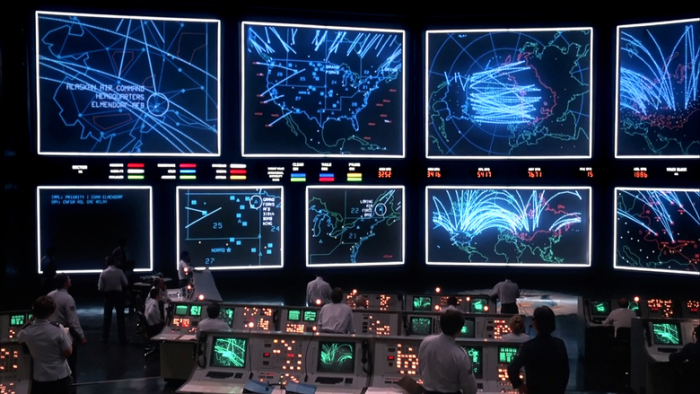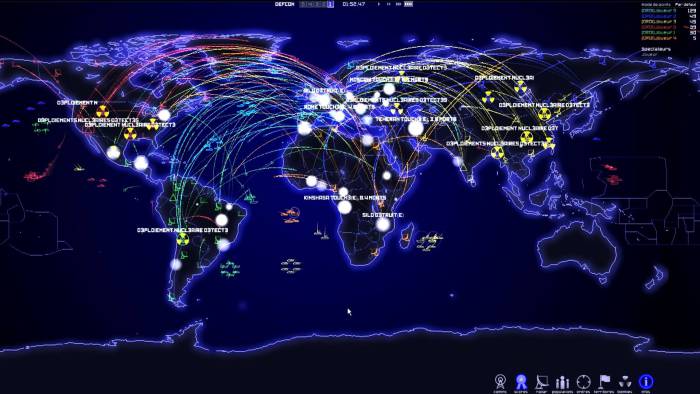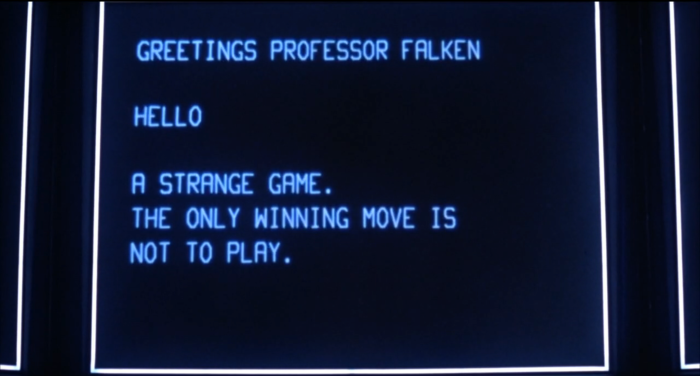Written by Stephen Patterson
In the 1940s and 1950s, the United States Air Force funded the creation of the RAND Corporation (Research and Development), an independent group of physicists, economists and social scientists. Their role was to research nuclear war strategy and assess the impact of nuclear bombing campaigns, the viability of retaliatory strikes, and oversee the development of new weapons, including the first hydrogen bomb, detonated in 1952 as part of Operation Ivy. This work involved mathematical and logistical considerations of vast proportions – and yet now, their work has been trivialised into some of the most recognisable movies and video games of the modern era. How do these experiences influence the development of the modern video game, and how do they enable us to better understand the potential impact and importance of nuclear diplomacy and strategic war?

WarGames (1983)
With the advent of the atomic age, as defined by the desolation of Hiroshima and Nagasaki, hit by American atomic bombs in August 1945, war as a broad concept changed almost entirely. In his book The Wizards of Armageddon, Fred Kaplan outlines behind-the-scenes efforts in American research and development, alongside Strategic Air Command (SAC), to find solutions to the issue of winning a nuclear conflict. This would result in the development of the M.A.D. doctrine (mutually assured destruction). The work conducted by scientists at RAND, and simultaneously in the Soviet Union throughout the latter half of the 20th century, helped result in some of the defining diplomatic concepts of the era. The film WarGames showed audiences in 1983 the continuing influence of technology on nuclear war: and how computation increasingly automated the process alongside the widespread proliferation of long range missile technology (in contrast to bombs, the payloads of which would have to be delivered by aircraft in the 1950s). This automation, progressing into the 1990s and now into the 21st century, allowed videogames to adopt the role of educating players on the colossal risks, but also intricate strategies, that encapsulated the back-and-forth nature of Cold War nuclear policy. In 1989, Nuclear War released on the Amiga, a videogame based on the card game of the same name. It showed a view of the Earth from space, and allowed players to command bombers and missiles to hit targets. It also incorporated elements of political and social control – the manufacturing speed of bombs and missiles increased the happier your population was with your leadership. Although it was a comedic take on conflict (one of the playable leaders is named Ronald Raygun), it demonstrated a playful desire to take control of devastatingly destructive weapons and experiment with nuclear strategies.
In two senses, the secretive development of the hydrogen bomb and subsequent posturing over nuclear weapons strategy has resulted in two major aspects of video games. The first is an extremely compelling setting for narrative storytelling – specifically in espionage. In 2011’s Call of Duty: Black Ops, we see the dramatised influence of cold war espionage brought to the forefront of video game storytelling. In one mission, you command a squad of special forces soldiers from an SR71 Blackbird (a strategic reconnaissance aircraft, first flown in 1964) in an attempt to infiltrate a Soviet radar base. Although the superweapon on display in this game takes the form of a chemical weapon, rather than nuclear warheads, the narrative follows the arc of Cold War dramatisation and deception closely. Similarly, Dynamighty’s Counterspy tells a tale of espionage in a race to prevent total nuclear annihilation. With each mission that passes, the DEFCON level races towards 1: representing the launch of missiles. By playing carefully and cautiously, you can avoid stoking tensions and thus avert disaster. Perhaps the most compelling of games set in the Cold War is Introversion Software’s DEFCON. You play as an armchair general – deciding where to deploy your submarines, which targets to hit and when to fire – bringing Protovision’s ‘Global Thermonuclear War’ from the film WarGames to life. Rather than a predefined narrative, you create your own (albeit horrifically destructive) tale.
Secondly, video games have developed so rapidly and allow the development of deeply engaging logical and strategic problems to tackle because that is exactly how those at RAND viewed the problem of nuclear war: a game to be won. Video games, especially grand strategy, have also closely reflected the immense influence nuclear weaponry has on world diplomacy and war. In grand strategy or ‘4X’ games set in early eras, such as Paradox Interactive’s Europa Universalis and Hearts of Iron, war strategy is focused on a more provincial scale. As time progresses, and the influence of empires becomes more far reaching, culminating in World War II in Hearts of Iron, strategy takes on a broader, more encompassing scale. But the introduction of nuclear weaponry – specifically Intercontinental Ballistic Missiles (ICBMs, able to hit targets from thousands of miles away) in the 1950s and onward entirely upends this focus on troop movements and base locations. In the Civilization series, the dawn of the atomic age reflects this change – atomic bombs and nuclear missiles can very quickly reduce amassed armies to ashes, levelling fortified locations and cities with the (literal) click of a button. Historically, this resulted in a vast overhaul of Air Force and general military strategy: the ability to hit major industrial centres, population centres and advancing armies with increasing ease as targeting systems improved made previous operational research (OR, developed in World War II) largely obsolete. In games it has largely the same impact: in Civilization, investments in surface-to-air missiles (SAMs), bombers, and city fortifications are no longer useful to you as a player. In a diplomatic sense, the AI is programmed to become fearful of players who have access to nuclear weapons, and can push for disarmament treaties and impose sanctions on those who do not adhere to them. The development of one new weapon in the technology tree changes the the entire landscape of war in the game and requires the player to change their approach immediately – especially if an opponent develops it first.

DEFCON (2006)
There are broader implications in the design and play of video games however that can be attributed to the way scientists in America and the Soviet Union have, in a way, influenced how video games now exist. In fact, a lot of the issues we see in video games, which often lead to the ability to ‘min-max’ or otherwise optimise builds and strategies are the result of flaws also present in early strategic nuclear planning. Modern video games are bound by pre-programmed logical constraints which assume that players will perform actions in certain ways: navigate levels in particular ways, interact with physics based objects in certain ways and so forth. In that way, the development of basic game theory by Von Neumann at RAND could be seen as crucial to the development of basic video game logic: the assumption that each player will attempt to maximize her rate of success within the confines of set rules. Von Neumann developed the classic Prisoner’s Dilemma and expanded upon it to create a set of defined rules for how games, of which nuclear war was a very large one, would operate – assuming all players would attempt to maximise their potential of winning. Machines such as the fictional WOPR in WarGames operate on a predefined set of logical pathways in this way – programmed to estimate bomber response times, missile trajectories and other anticipated results of nuclear war scenarios based on mathematics and expected player responses.
Video games utilise game theory (as you would expect) in increasingly complicated manners as development and programming capability increases over the years. Most basically, we can look to non-player character AI as a benchmark for the improved quality, especially in tactical first person shooters. Monolith’s 2005 shooter F.E.A.R. remains an often cited example. In more complex systems, computer opponents are programmed to respond in certain varying manners to a vast array of situations – as demonstrated by the AI in Civilization above and it’s response to the development of nuclear weapons; a behavioural shift towards non-aggression, passivity and diplomatic appeasement. In Civilization, for example, beating the game on Deity difficulty (the hardest difficulty setting) can be approached in such a way that ensures you the highest chance of success, as involved and complicated as that may be, due to the nature of the way AI is programmed to act and respond. A modern war game which plays out in much the same way as very early predictions of Soviet approaches to nuclear strategy – based on logic and game theory. We owe the design of these complex models to the work of military scientists and economists in the Cold War: especially the influence and growth of computer programming in the Second World War and the Cold War, without which we would not be talking about video games today.

Where this analysis of game theory becomes most interesting is when we consider how similar nuclear strategy becomes to modern, evolving ‘metagames’. As in the continually changing diplomatic and military scenarios of the second half of the 20th century – including advances in available technology and especially the political climate of both the USA and USSR – videogames evolve incredibly rapidly. In highly competitive environments such as League of Legends, Dota 2 and Starcraft 2, preferred strategies change over time due to circumstances beyond the control of the players. In much the same way as the Cold War, a player in Starcraft may develop a new ‘tech’ which invalidates old strategies and requires adaptation. In this case, there is unlikely to be any direct correlation between the two schools of thought. However, the similarity between colossally vast calculations of risk and vulnerability in nuclear strategy and selecting the most effective hero composition in Dota 2 strategy is striking.
The similarity is so striking in fact that the two are now bleeding over – some military drones are now controlled with Xbox 360 controllers. War has become gamified, remote and detached from reality. Just like video games.
Books referenced in this text include Fred Kaplan’s The Wizards of Armageddon and Eric Schlosser’s Command & Control. For more information of the development and critique of video games at a systems level, I recommend Unit Operations: An Approach to Video Game Criticism by Ian Bogost. Thank you for reading.
Advertisements Share this:




